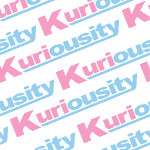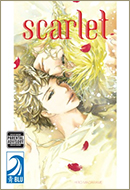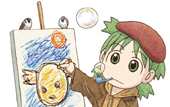   |
Manga-ka: Nakaba Higurashi
Publisher: CMX Manga
Rating: Older Teen (16+)
Release Date: May 2009
Synopsis: “Temujin (later to be called Genghis Khan) was born to the leader of a Mongolian clan with all portents of greatness: a glowing face and fire in his eyes. When Temujin is 11 years old, he meets a boy from another tribe–Jamuqa–while hunting down a deer. Before they can decide who will keep the kill, they save each other from stalking wolves. To honour their newly established friendship, the two boys become blood brothers, swearing eternal loyalty to each other as long as they shall live. After some years, however, both Temujin and Jamuqa have the ambition to contend for supremacy of Mongolia, and they become enemies. ”
Adaptations can be a difficult process, and despite some solid artistic skills, Nakaba Higurashi’s presentation of Morimura’s story leaves a bit to be desired. Full of sweeping nomadic images, it’s impact is softened by frequent jumps in narrative, a lack of focus, and a more sedate pace then usual for action manga. Ultimately it emerges as a pleasant yet flawed work, conveying a fragmented tale of tragedy as Khan starts his quest for greatness.
Whether the confusing narrative is an aspect of the source work, or Higurashi cherry picking from scenes in the novels, the focus is often unclear. I had trouble keeping track of Ghengis/Temujin’s siblings early on, and the quick flash forward to his adult life and his similar subset of sons didn’t help things. I was very confused by these initial chapters, unsure if I was still following the life story of the younger Temujin we met in the initial chapters that give a brief glimpse of his early life. Higurashi quickly moves onto his later life as his tribes’ leader, and the transition isn’t as clean as it could be. In addition, the later story’s attention span keeps switching between Temujin and his son, trying to draw parallels between two sets of friends who must betray each other in what could be an intriguing tale, but unable to devote enough story time to either for it to be a full emotional experience. This narrative is further conflicted by the fairly weak approach to the action elements of the manga.
The violence of Ghengis Khan is mostly bloodless. Warriors are acknowledged as being killed in the field of war, but it isn’t precisely shown, and Higurashi shies away from showing too much onscreen violence in general. Readers accustomed to more action packed and blood-drenched historical manga set in Asia’s past will likely be disappointed. There are a few scenes where the characters actions in combat are fairly clear and brutal, such as a scene where one of Jamuqa’s minions takes on one of Ghengis’s tribe, but for the most part more attention is paid to conversational scenes, which makes for a lot of talking heads. There are lots of sweeping scenes that show Higurashi could handle action well, but by toning things down the war seems less dramatic. Perhaps she was aiming for a younger audience by keeping the violence fairly tame, but I felt a little more could have been depicted without crossing the line into gruesome territory. Given the finale of the book and it’s depiction of the futile consequences of war, Higurashi surely could of reinforced some of the book’s themes by presenting a slightly more realistic view of the aftermath of the early battles.
Despite her narrative shortfalls, Higurashi’s art is generally competent, with extensive scenes of horse riding, and a tribal setting that is visually distinct and avoids the easy trap of a more Japanese setting. Structures are clearly temporary dwellings, and reflect the nomadic lives depicted in the work. The scenery gives you a sense of a faraway civilization, set in a sprawling landscape far away from the isles of Japan. Higurashi draws excellent horses, and excels at complex scenes where riders combat while riding them, and pays attention to match the regional breed’s more squat nature. Stocky, furry and vaguely reminiscent of 80’s icon and Junko Mizuno obsession My Little Pony, with their sizeable noggins they add to the visual appeal and landscape. In terms of figure work, the costumes are detailed, and avoids anime-styling, instead focusing on giving a sense of realism in figure work and facial expressions. While the story does stray to talking heads at some points, Higurashi’s skills at figure work does surface from time to time, making me wish she had devoted more time or had more pages to depict the epic battles we only get glimpses of between scenes of family life. It left me curious about her other works, hoping CMX might opt to import future works given the promise seen in the art.
CMX’s binding and paper makes for a nice reading experience, and is spiffed up a bit by a colour insert common to their other Flex imprinted books. While CMX spine indicates this as Vol.1, it is actually a single volume adaptation of a novel of the same title, which was also adapted into a movie released by Funimation. CMX’s presentation is excellent though, with translated sound effects, no Japanese-honourifics that would have been out of place in 13th century Mongolia, and crisp, clean printing one would expect from a publishing house as venerable as DC Comics, with production work on CMX titles handled by their WildStorm imprint. CMX also includes a short essay addressing the differences between the film and the manga, as well as elaborating some of the elements left out of this edition.
Being a single volume work makes it a low commitment purchase, yet there are more entertaining historical works being published in the English manga market, so I would suggest checking out Vagabond, Lone Wolf and Cub, or even the more fantastical and not entirely historically accurate Ruroni Kenshin or Ooku first. These may be more lengthy works, but offer more solid reading experiences. Still ,if you’re really into historical manga, the artwork might make Ghengis Khan a moderately entertaining pickup for you. Otherwise, there’s better titles in CMX’s catalogue, and in this genre being published in North American.
While I was impressed with Higurashi’s strong visual style, the often confusing tale of revenge and political intrigue attempts to tell a story of two former friends who must betray one another for the sake of their chosen destiny. Rushed along and accompanied by confusing flashbacks, what could be a dramatic tale is muted, and relegated to explanatory bits, picking up a bit towards the end, but ultimately unsatisfying. While never outright bad, and featuring fairly solid artwork, Genghis Khan doesn’t really stand well on its own, acting as one of the weaker CMX releases.
Review written May 14, 2010 by Andre
Book provided by CMX for review purposes


 Follow
Follow
























[…] Kelakagand on vol. 5 of Fushigi Yugi (VizBig edition) (Kelakagandy’s Ramblings) Andre on Genghis Khan (Kuriousity) Sean Gaffney on vol. 8 of Gin Tama (A Case Suitable for Treatment) Lori Henderson on […]